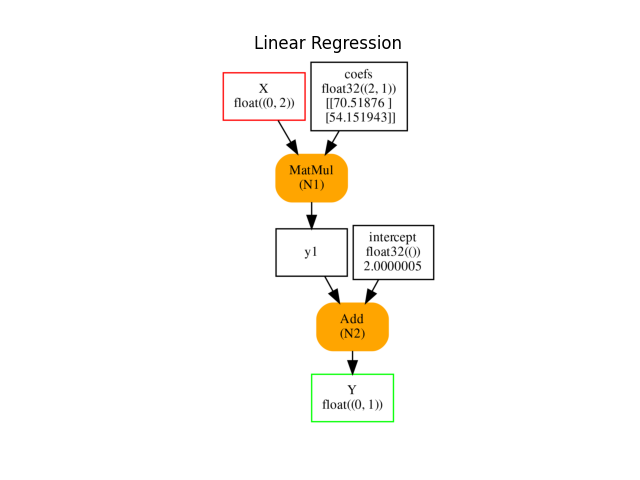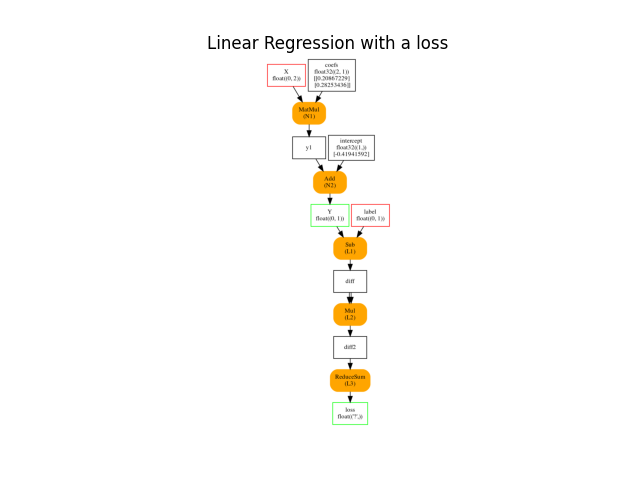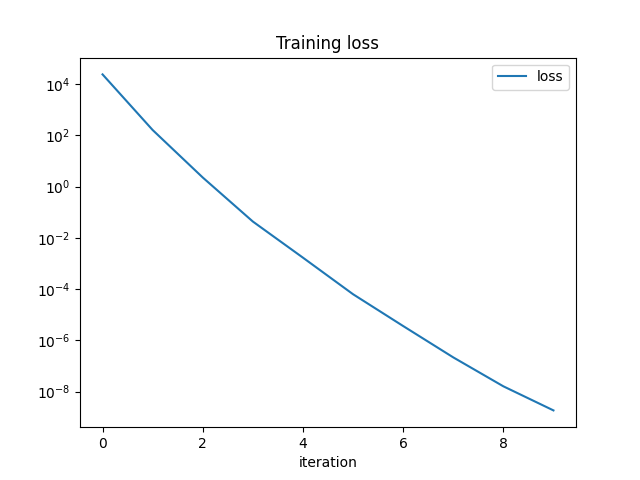Note
Click here to download the full example code
Train a linear regression with onnxruntime-training in details¶
onnxruntime-training only computes the gradient values. A gradient descent can then use it to train a model. This example goes step by step from the gradient computation to the gradient descent to get a trained linear regression.
A simple linear regression with scikit-learn¶
from pprint import pprint
import numpy
from pandas import DataFrame
from onnx import helper, numpy_helper, TensorProto
from onnxruntime import (
InferenceSession, __version__ as ort_version,
TrainingParameters, SessionOptions, TrainingSession)
from sklearn.datasets import make_regression
from sklearn.model_selection import train_test_split
from sklearn.linear_model import LinearRegression
from onnxcustom.plotting.plotting_onnx import plot_onnxs
from tqdm import tqdm
X, y = make_regression(n_features=2, bias=2)
X = X.astype(numpy.float32)
y = y.astype(numpy.float32)
X_train, X_test, y_train, y_test = train_test_split(X, y)
lr = LinearRegression()
lr.fit(X, y)
print(lr.predict(X[:5]))
Out:
[-123.35968 -48.77173 54.596222 76.6724 71.26569 ]
An equivalent ONNX graph.¶
This graph can be obtained with *sklearn-onnx`
(see Train a linear regression with onnxruntime-training).
For clarity, this step is replaced by
next function which builds the exact same graph. It
implements a linear regression with onnx operators.
def onnx_linear_regression(coefs, intercept):
if len(coefs.shape) == 1:
coefs = coefs.reshape((1, -1))
coefs = coefs.T
# input and output
X = helper.make_tensor_value_info(
'X', TensorProto.FLOAT, [None, coefs.shape[0]])
Y = helper.make_tensor_value_info(
'Y', TensorProto.FLOAT, [None, coefs.shape[1]])
# inference
node_matmul = helper.make_node('MatMul', ['X', 'coefs'], ['y1'], name='N1')
node_add = helper.make_node('Add', ['y1', 'intercept'], ['Y'], name='N2')
# initializer
init_coefs = numpy_helper.from_array(coefs, name="coefs")
init_intercept = numpy_helper.from_array(intercept, name="intercept")
# graph
graph_def = helper.make_graph(
[node_matmul, node_add], 'lr', [X], [Y],
[init_coefs, init_intercept])
model_def = helper.make_model(
graph_def, producer_name='orttrainer', ir_version=7,
producer_version=ort_version,
opset_imports=[helper.make_operatorsetid('', 14)])
return model_def
onx = onnx_linear_regression(lr.coef_.astype(numpy.float32),
lr.intercept_.astype(numpy.float32))
Let’s visualize it.
plot_onnxs(onx, title="Linear Regression")

Out:
<AxesSubplot:title={'center':'Linear Regression'}>
We check it produces the same outputs.
sess = InferenceSession(onx.SerializeToString(),
providers=['CPUExecutionProvider'])
print(sess.run(None, {'X': X[:5]})[0])
Out:
[[-123.35968 ]
[ -48.77173 ]
[ 54.596222]
[ 76.6724 ]
[ 71.26569 ]]
It works.
Training with onnxruntime-training¶
The model can be trained with a gradient descent algorithm. The previous graph only predicts. A new graph needs to be created to compute the loss as function of the inputs and the expected outputs. In our case, it is a square loss. The new graph then requires two inputs, the features and the labels. It has two outputs, the predicted values and the loss.
def onnx_linear_regression_training(coefs, intercept):
if len(coefs.shape) == 1:
coefs = coefs.reshape((1, -1))
coefs = coefs.T
# input
X = helper.make_tensor_value_info(
'X', TensorProto.FLOAT, [None, coefs.shape[0]])
# expected input
label = helper.make_tensor_value_info(
'label', TensorProto.FLOAT, [None, coefs.shape[1]])
# output
Y = helper.make_tensor_value_info(
'Y', TensorProto.FLOAT, [None, coefs.shape[1]])
# loss
loss = helper.make_tensor_value_info('loss', TensorProto.FLOAT, [])
# inference
node_matmul = helper.make_node('MatMul', ['X', 'coefs'], ['y1'], name='N1')
node_add = helper.make_node('Add', ['y1', 'intercept'], ['Y'], name='N2')
# loss
node_diff = helper.make_node('Sub', ['Y', 'label'], ['diff'], name='L1')
node_square = helper.make_node(
'Mul', ['diff', 'diff'], ['diff2'], name='L2')
node_square_sum = helper.make_node(
'ReduceSum', ['diff2'], ['loss'], name='L3')
# initializer
init_coefs = numpy_helper.from_array(coefs, name="coefs")
init_intercept = numpy_helper.from_array(intercept, name="intercept")
# graph
graph_def = helper.make_graph(
[node_matmul, node_add, node_diff, node_square, node_square_sum],
'lrt', [X, label], [loss, Y], [init_coefs, init_intercept])
model_def = helper.make_model(
graph_def, producer_name='orttrainer', ir_version=7,
producer_version=ort_version,
opset_imports=[helper.make_operatorsetid('', 14)])
return model_def
We create a graph with random coefficients.
onx_train = onnx_linear_regression_training(
numpy.random.randn(*lr.coef_.shape).astype(numpy.float32),
numpy.random.randn(
*lr.intercept_.reshape((-1, )).shape).astype(numpy.float32))
plot_onnxs(onx_train, title="Linear Regression with a loss")

Out:
<AxesSubplot:title={'center':'Linear Regression with a loss'}>
DataLoader¶
Next class draws consecutive random observations from a dataset
by batch. It iterates over the datasets by drawing n consecutive
observations. This class is equivalent to
OrtDataLoader.
class DataLoader:
"""
Draws consecutive random observations from a dataset
by batch. It iterates over the datasets by drawing
*batch_size* consecutive observations.
:param X: features
:param y: labels
:param batch_size: batch size (consecutive observations)
"""
def __init__(self, X, y, batch_size=20):
self.X, self.y = X, y
self.batch_size = batch_size
if len(self.y.shape) == 1:
self.y = self.y.reshape((-1, 1))
if self.X.shape[0] != self.y.shape[0]:
raise ValueError(
"Shape mismatch X.shape=%r, y.shape=%r." % (
self.X.shape, self.y.shape))
def __len__(self):
"Returns the number of observations."
return self.X.shape[0]
def __iter__(self):
"""
Iterates over the datasets by drawing
*batch_size* consecutive observations.
"""
N = 0
b = len(self) - self.batch_size
while N < len(self):
i = numpy.random.randint(0, b)
N += self.batch_size
yield (self.X[i:i + self.batch_size],
self.y[i:i + self.batch_size])
@property
def data(self):
"Returns a tuple of the datasets."
return self.X, self.y
data_loader = DataLoader(X_train, y_train, batch_size=2)
for i, batch in enumerate(data_loader):
if i >= 2:
break
print("batch %r: %r" % (i, batch))
Out:
batch 0: (array([[-1.9480568 , 1.6599144 ],
[ 0.07494847, 0.04851316]], dtype=float32), array([[-45.48698 ],
[ 9.912355]], dtype=float32))
batch 1: (array([[-0.18353084, -1.5851127 ],
[ 0.19202179, -1.2771447 ]], dtype=float32), array([[-96.779305],
[-53.618725]], dtype=float32))
First iterations of training¶
Prediction needs an instance of class InferenceSession, the training needs an instance of class TrainingSession. Next function creates this one.
def create_training_session(
training_onnx, weights_to_train, loss_output_name='loss',
training_optimizer_name='SGDOptimizer'):
"""
Creates an instance of class `TrainingSession`.
:param training_onnx: ONNX graph used to train
:param weights_to_train: names of initializers to be optimized
:param loss_output_name: name of the loss output
:param training_optimizer_name: optimizer name
:return: instance of `TrainingSession`
"""
ort_parameters = TrainingParameters()
ort_parameters.loss_output_name = loss_output_name
output_types = {}
for output in training_onnx.graph.output:
output_types[output.name] = output.type.tensor_type
ort_parameters.weights_to_train = set(weights_to_train)
ort_parameters.training_optimizer_name = training_optimizer_name
ort_parameters.optimizer_attributes_map = {
name: {} for name in weights_to_train}
ort_parameters.optimizer_int_attributes_map = {
name: {} for name in weights_to_train}
session_options = SessionOptions()
session_options.use_deterministic_compute = True
session = TrainingSession(
training_onnx.SerializeToString(), ort_parameters, session_options)
return session
train_session = create_training_session(onx_train, ['coefs', 'intercept'])
print(train_session)
Out:
<onnxruntime.capi.training.training_session.TrainingSession object at 0x7f5d7b6977c0>
Let’s look into the expected inputs and outputs.
for i in train_session.get_inputs():
print("+input: %s (%s%s)" % (i.name, i.type, i.shape))
for o in train_session.get_outputs():
print("output: %s (%s%s)" % (o.name, o.type, o.shape))
Out:
+input: X (tensor(float)[None, 2])
+input: label (tensor(float)[None, 1])
+input: Learning_Rate (tensor(float)[1])
output: loss (tensor(float)[1, 1])
output: Y (tensor(float)[None, 1])
output: global_gradient_norm (tensor(float)[])
A third parameter Learning_Rate was automatically added. The training updates the weight with a gradient multiplied by this parameter. Let’s see now how to retrieve the trained coefficients.
state_tensors = train_session.get_state()
pprint(state_tensors)
Out:
{'coefs': array([[0.20867229],
[0.28253436]], dtype=float32),
'intercept': array([-0.41941592], dtype=float32)}
We can now check the coefficients are updated after one iteration.
inputs = {'X': X_train[:1],
'label': y_train[:1].reshape((-1, 1)),
'Learning_Rate': numpy.array([0.001], dtype=numpy.float32)}
train_session.run(None, inputs)
state_tensors = train_session.get_state()
pprint(state_tensors)
Out:
{'coefs': array([[0.9041854],
[0.639641 ]], dtype=float32),
'intercept': array([-0.04783082], dtype=float32)}
They changed. Another iteration to be sure.
inputs = {'X': X_train[:1],
'label': y_train[:1].reshape((-1, 1)),
'Learning_Rate': numpy.array([0.001], dtype=numpy.float32)}
res = train_session.run(None, inputs)
state_tensors = train_session.get_state()
pprint(state_tensors)
Out:
{'coefs': array([[1.5921495],
[0.9928715]], dtype=float32),
'intercept': array([0.31972107], dtype=float32)}
It works. The training loss can be obtained by looking into the results.
pprint(res)
Out:
[array([[33773.598]], dtype=float32),
array([[2.259293]], dtype=float32),
array(856.248, dtype=float32)]
Training¶
We need to implement a gradient descent. Let’s wrap this into a class similar following scikit-learn’s API.
class CustomTraining:
"""
Implements a simple :epkg:`Stochastic Gradient Descent`.
:param model_onnx: ONNX graph to train
:param weights_to_train: list of initializers to train
:param loss_output_name: name of output loss
:param max_iter: number of training iterations
:param training_optimizer_name: optimizing algorithm
:param batch_size: batch size (see class *DataLoader*)
:param eta0: initial learning rate for the `'constant'`, `'invscaling'`
or `'adaptive'` schedules.
:param alpha: constant that multiplies the regularization term,
the higher the value, the stronger the regularization.
Also used to compute the learning rate when set to *learning_rate*
is set to `'optimal'`.
:param power_t: exponent for inverse scaling learning rate
:param learning_rate: learning rate schedule:
* `'constant'`: `eta = eta0`
* `'optimal'`: `eta = 1.0 / (alpha * (t + t0))` where *t0* is chosen
by a heuristic proposed by Leon Bottou.
* `'invscaling'`: `eta = eta0 / pow(t, power_t)`
:param verbose: use :epkg:`tqdm` to display the training progress
"""
def __init__(self, model_onnx, weights_to_train, loss_output_name='loss',
max_iter=100, training_optimizer_name='SGDOptimizer',
batch_size=10, eta0=0.01, alpha=0.0001, power_t=0.25,
learning_rate='invscaling', verbose=0):
# See https://scikit-learn.org/stable/modules/generated/
# sklearn.linear_model.SGDRegressor.html
self.model_onnx = model_onnx
self.batch_size = batch_size
self.weights_to_train = weights_to_train
self.loss_output_name = loss_output_name
self.training_optimizer_name = training_optimizer_name
self.verbose = verbose
self.max_iter = max_iter
self.eta0 = eta0
self.alpha = alpha
self.power_t = power_t
self.learning_rate = learning_rate.lower()
def _init_learning_rate(self):
self.eta0_ = self.eta0
if self.learning_rate == "optimal":
typw = numpy.sqrt(1.0 / numpy.sqrt(self.alpha))
self.eta0_ = typw / max(1.0, (1 + typw) * 2)
self.optimal_init_ = 1.0 / (self.eta0_ * self.alpha)
else:
self.eta0_ = self.eta0
return self.eta0_
def _update_learning_rate(self, t, eta):
if self.learning_rate == "optimal":
eta = 1.0 / (self.alpha * (self.optimal_init_ + t))
elif self.learning_rate == "invscaling":
eta = self.eta0_ / numpy.power(t + 1, self.power_t)
return eta
def fit(self, X, y):
"""
Trains the model.
:param X: features
:param y: expected output
:return: self
"""
self.train_session_ = create_training_session(
self.model_onnx, self.weights_to_train,
loss_output_name=self.loss_output_name,
training_optimizer_name=self.training_optimizer_name)
data_loader = DataLoader(X, y, batch_size=self.batch_size)
lr = self._init_learning_rate()
self.input_names_ = [i.name for i in self.train_session_.get_inputs()]
self.output_names_ = [
o.name for o in self.train_session_.get_outputs()]
self.loss_index_ = self.output_names_.index(self.loss_output_name)
loop = (
tqdm(range(self.max_iter))
if self.verbose else range(self.max_iter))
train_losses = []
for it in loop:
loss = self._iteration(data_loader, lr)
lr = self._update_learning_rate(it, lr)
if self.verbose > 1:
loop.set_description("loss=%1.3g lr=%1.3g" % (loss, lr))
train_losses.append(loss)
self.train_losses_ = train_losses
self.trained_coef_ = self.train_session_.get_state()
return self
def _iteration(self, data_loader, learning_rate):
"""
Processes one gradient iteration.
:param data_lower: instance of class `DataLoader`
:return: loss
"""
actual_losses = []
lr = numpy.array([learning_rate], dtype=numpy.float32)
for batch_idx, (data, target) in enumerate(data_loader):
if len(target.shape) == 1:
target = target.reshape((-1, 1))
inputs = {self.input_names_[0]: data,
self.input_names_[1]: target,
self.input_names_[2]: lr}
res = self.train_session_.run(None, inputs)
actual_losses.append(res[self.loss_index_])
return numpy.array(actual_losses).mean()
Let’s now train the model in a very similar way that it would be done with scikit-learn.
trainer = CustomTraining(onx_train, ['coefs', 'intercept'], verbose=1,
max_iter=10)
trainer.fit(X, y)
print("training losses:", trainer.train_losses_)
df = DataFrame({"iteration": numpy.arange(len(trainer.train_losses_)),
"loss": trainer.train_losses_})
df.set_index('iteration').plot(title="Training loss", logy=True)

Out:
0%| | 0/10 [00:00<?, ?it/s]
100%|##########| 10/10 [00:00<00:00, 312.06it/s]
training losses: [23782.207, 160.85303, 2.2581344, 0.04318724, 0.001682495, 6.3030675e-05, 3.6188994e-06, 2.1655846e-07, 1.609759e-08, 1.8486048e-09]
<AxesSubplot:title={'center':'Training loss'}, xlabel='iteration'>
Let’s compare scikit-learn trained coefficients and the coefficients obtained with onnxruntime and check they are very close.
print("scikit-learn", lr.coef_, lr.intercept_)
print("onnxruntime", trainer.trained_coef_)
Out:
scikit-learn [70.51876 54.151943] 2.0000005
onnxruntime {'coefs': array([[70.51876 ],
[54.151943]], dtype=float32), 'intercept': array([2.0000045], dtype=float32)}
It works. We could stop here or we could update the weights in the training model or the first model. That requires to update the constants in an ONNX graph.
Update weights in an ONNX graph¶
Let’s first check the output of the first model in ONNX.
sess = InferenceSession(onx.SerializeToString(),
providers=['CPUExecutionProvider'])
before = sess.run(None, {'X': X[:5]})[0]
print(before)
Out:
[[-123.35968 ]
[ -48.77173 ]
[ 54.596222]
[ 76.6724 ]
[ 71.26569 ]]
Let’s replace the initializer.
def update_onnx_graph(model_onnx, new_weights):
replace_weights = []
replace_indices = []
for i, w in enumerate(model_onnx.graph.initializer):
if w.name in new_weights:
replace_weights.append(
numpy_helper.from_array(new_weights[w.name], w.name))
replace_indices.append(i)
replace_indices.sort(reverse=True)
for w_i in replace_indices:
del model_onnx.graph.initializer[w_i]
model_onnx.graph.initializer.extend(replace_weights)
update_onnx_graph(onx, trainer.trained_coef_)
Let’s compare with the previous output.
sess = InferenceSession(onx.SerializeToString(),
providers=['CPUExecutionProvider'])
after = sess.run(None, {'X': X[:5]})[0]
print(after)
Out:
[[-123.35967 ]
[ -48.771725]
[ 54.596226]
[ 76.67241 ]
[ 71.2657 ]]
It looks almost the same but slighly different.
print(after - before)
Out:
[[7.6293945e-06]
[3.8146973e-06]
[3.8146973e-06]
[7.6293945e-06]
[7.6293945e-06]]
Next example will show how to train a linear regression on GPU: Train a linear regression with onnxruntime-training on GPU in details.
# import matplotlib.pyplot as plt
# plt.show()
Total running time of the script: ( 0 minutes 2.868 seconds)